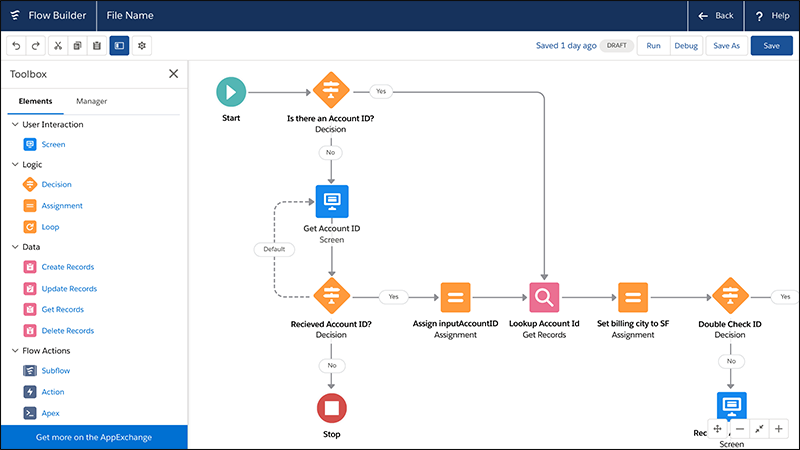Top Suggestions To Selecting application development with Low-code platforms
Wiki Article
Benefits Of Low Code Application Development In Relation To Integration Capabilities
Low-code applications offer significant benefits for integration, which is vital when developing applications that seamlessly connect to different systems and services. Here are a few of the main advantages: Prebuilt Connectors and APIs
Wide Range of Connectors Low-code platforms generally include a wide range of pre-built connectors for the most popular enterprise software (e.g., CRM, ERP databases, cloud services, etc.). This simplifies integration with the systems.
API Integration - Many low-code platforms include API integration, which gives developers to easily access external data sources or services.
Simple to use
Drag-and-Drop Integration: Many integration tasks are performed by using drag-and-drop interfaces. This lets developers and non-developers to build complicated integrations with minimal or no programming.
Visual Workflow Builders: Tools for creating workflows and data flow which are visualized help learn and configure integrations in a more intuitive method.
Standardized Integration Methods:
SOAP and restful services: Supporting web services common protocols such as REST or SOAP makes integration simple with many different systems and applications.
OData Other Standards Support for standards like OData facilitates the transfer and manipulation of data across applications and platforms.
Real-Time Data Synchronization:
Real-Time Integrations: Low-code systems can handle real-time data transfer between systems and applications. This makes sure that the data is up to date and consistent across the entire organization.
Event-Driven Architect: Certain platforms have structures that are event driven, allowing applications to respond immediately to events. This is essential for interactive and dynamic applications.
Legacy System Integration:
Interconnecting old Systems and new Systems Low-code platform often provides the tools needed to integrate with legacy systems. This allows organisations to upgrade their IT Infrastructure without overhauling the existing systems.
Data Migration Tools - Built-in data migration tools allow you to transfer data from older systems to low-code applications.
Third-Party Service Integration:
Cloud Services Integration: Easy scaling and deployment of applications is possible with seamless integration with cloud services like AWS, Azure and Google Cloud.
Integration of Business Applications: Lowcode platforms can be utilized to connect various business applications including Salesforce, SAP, Microsoft Dynamics etc. and create a unified workflow among different business functions.
Simple Data Management:
Unified Data Modells: Some lowcode platforms have unification of coding models that simplify managing data and integration, as well as synchronization across different systems.
Data Connectors are pre-configured data connectors which provide rapid access to data sources and allow manipulation.
Security and Compliance:
Low-code integration platforms comply with security standards to protect the data during transport or in rest.
These platforms are usually equipped with features that help in ensuring compliance (e.g. HIPAA, GDPR) and provide peace of mind to businesses dealing with sensitive data.
Extensibility:
Custom Code and Scripts: Low-code platforms are often able to handle more complicated integrations by allowing the inclusion of custom scripts and code. This allows for greater flexibility without compromising on the ease of use.
Plug-in Ecosystems: A plug in ecosystem can be used to expand the integration capabilities and allows users to add more features as needed.
The overall low-code platform's capabilities to integrate makes it an effective tool to create interconnected applications which are scalable and efficient. They are able to streamline the process for connecting disparate systems and enhance the flow of information. Companies can leverage existing technologies and adopt new ones while maintaining a cohesive IT environment. Take a look at the best Low-code Platform for application development recommendations for blog recommendations including rapid applications, app modernisation, cross platform mobile development, software for app development, database in azure, azure sql databases, app modernization, application modernisation, mobile development platforms, cloud software applications and more.

The Low-Cost Of Development Is One Of The Main Advantages.
Low-code development has many benefits in terms of cost-effectiveness. This makes it a good option for companies looking to optimize their development budgets, while still delivering high quality applications. Here are the key benefits: Reduced development costs:
Less Coding Needed: Low-code platform eliminates the need for long manual code. This saves time and effort on the part of developers while developing applications. This translates to lower labor costs.
Less Developer Resources: Because low-code development is quicker and simpler, fewer specialized developers are needed. This can drastically reduce costs for hiring and staffing.
More rapid time to market
Accelerated Development: Low-code platforms provide visual development tools, pre-built components and other tools that allow rapid development of applications. Businesses can introduce their products to the market more quickly. This can lead to increased revenue and a better positioning in the market.
Rapid Prototyping. Businesses can quickly test and create prototypes. This reduces time spent during the development phase, and allows for quicker iterations dependent on the feedback of users.
Lower cost of maintenance:
Because of their modular design and standardised components, low-code platforms generally simplify the maintenance of applications. This reduces the cost of maintaining the system over time.
Automated updates: A lot of low-code platforms automatically manage updates and patches, ensuring that applications are secure and up to date with no need for a lengthy manual intervention.
Efficient Resource Utilization:
Contributions from non-developers: Low code platforms empower non-developers, for example, business users to participate in the development process. This decentralization of development enables companies to tap into the expertise of a wider range of employees, while reducing dependence on high-paying developers.
IT departments can focus on Strategic Initiatives: Instead, of being overwhelmed by the daily tasks of development IT departments can concentrate their energies on strategic initiatives to increase productivity and efficiency.
Price models that are scaleable:
Subscription Pricing: Many platforms with low-code support different pricing options based on subscriptions which are scalable depending on the usage. This allows businesses the ability to adjust their spending in line with the growth of their business and its needs without having to pay large upfront costs.
Pay-as-you-go: Certain platforms provide pay-as-you-go options. This lets companies only pay for the resources they actually use. This is particularly beneficial for small businesses and startups with a limited budget.
Costs for reduced Third-Party Software:
Built-in Functionalities: Low-code platforms are equipped with a wide range of integrated features and integrations which make it less necessary to use third-party software and tools. Subscription fees and licensing charges are also reduced.
Pre-Built Integrations: Availability of pre-built integrations that integrate with the most popular systems and services reduces the need for custom development, saving both time and money.
Better ROI:
A faster return on investment: Combining rapid development with lower costs and a faster speed to market, businesses can achieve an increased ROI on their investment (ROI).
Enhanced Agility. Businesses can swiftly adapt to market changes and customer requirements, ensuring they remain relevant. They also can capitalize on new business opportunities as they arise.
Costs of training are lower:
User-Friendly Interfaces: The intuitive interfaces and user-friendly functions of low-code platforms reduce the learning curve thus reducing the need to conduct lengthy training.
Accessible Resources that are accessible. A lot of low-code platforms offer complete training materials and tutorials as well as community support. They reduce the need to undergo formal training, which can be costly.
Streamlined collaboration:
Collaboration Tools: Integrated collaboration tools enhance communication and coordination between teams, which results in improved processes for development, and less overhead.
Unified Development Environment : A unified environment makes work easier and reduces the costs associated with managing various platforms and tools.
The overall cost-effectiveness of low-code software development is due to its ability to cut down on the cost of maintenance and development as well as increase the time to market as well as optimize the use of resources and also provide flexible pricing models. Low-code provides significant financial benefits to businesses. Read the best wavemaker.com coding for website examples including software for app development, cross platform app dev, app modernisation, push notifications android, develop web application, develop cross platform mobile app, stored sql procedures, cross platform mobile development, low code development platforms, lowcode no code and more.
Benefits Of Low-Code Application Development With Regard To Customization And Constraints
Low-code application development is a balanced solution that has significant advantages in addressing limitations while allowing customization. Here are a few key benefits.
Removing Complexity Barriers
Low-code development platforms are easier to use since they offer already-built components, templates and other tools. They also facilitate rapid deployment of even the most complicated applications.
Guided Workflows - Many platforms have guided workflows or wizards that assist developers with complicated procedures. This reduces the risk of errors and assures the sameness of the process.
Scalability solutions:
Scalability is built into: Low-code platform often includes features that allow for scalable architecture. Applications can handle increased workloads with minimal changes.
Performance Monitoring: Integrated tools for monitoring performance and optimization ensure that applications remain efficient as they expand.
Security and compliance:
Security features integrated into low-code platforms offer security measures like encryption as well as role-based access control, and automated compliance checking that address the most common security concerns.
Regular Updates: Platforms frequently update their security protocol and compliance measures. This makes sure that applications remain secure from new threats.
Customization Options:
Extensibility:
Low-code platforms can often be able to incorporate custom code, for instance, JavaScript or Python, allowing developers to extend their functionality beyond what is typical.
Developers are able to create custom modules and plugins that add functionality specifically tailored to meet the needs of specific businesses.
APIs and Integration
API Support: Comprehensive API support allows seamless integration of services and systems from outside. This enables extensive customization and connectivity.
Third Party Services: Low-code platforms usually provide pre-built connectors for well-known third-party services, which makes it easier to customize and integrate applications.
Flexible Design for UI/UX:
User-friendly interfaces that can be customized: Users are able to modify and create their own user interfaces, which will provide an experience that is more customized.
Responsive design: The ability to customize applications for different devices and screens is built-in.
Customizing Business Logic is easy:
Visual Workflow Builders - Visual tools that allow you to build and modify workflows. business logic and procedures allow developers to create intricate and custom processes with no the need for programming.
Platforms come with conditional Logic, which allows for the development of custom scripts to address particular scenarios and business rules.
Data Management:
Custom Data Models Developers can choose to develop custom data models specifically for particular applications, and tailoring the handling of data to specific business requirements.
Advanced Data Processing: Integration with advanced data processing tools and capabilities allows for customization in how data is analyzed and utilized within the application.
Balancing Customization with Limitations
Frameworks and Standards
Low-code platforms encourage industry best practices and standards: Low code platforms encourage adhering to industry best standards and practices. This helps to maintain high-quality, secure, and flexible applications.
Governance Frameworks. Built-in frameworks of governance ensure that customizations will not compromise the security, compliance or the integrity of the application.
Iterative Development:
Rapid prototyping: The capability to rapidly prototype and test customizations ensures that developers can modify their designs based on feedback from users, refining the application to meet the needs of users.
Continuous Improvement: Low code platforms allow for constant improvements. They can be customized and enhanced when business requirements change.
Empowering Users
Helping Citizen developers become empowered: The Low-Code platform's intuitive interfaces allow non-developers make customizations. This boosts the number of users who are able to improve and customize applications.
Training and Support A lot of platforms provide extensive instruction and resources that assist users to customize their applications, without compromising its stability or performance.
Overall, low code application development provides a robust framework to address limitations and provide ample options for customization. This balance enables businesses to develop and maintain applications which are functional, tailored for their specific needs and meet the highest standards in terms of security, quality and scaleability.

